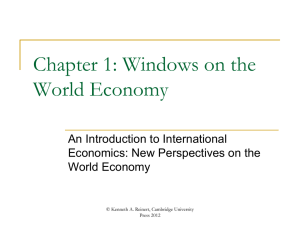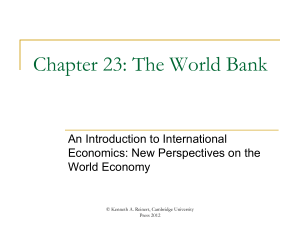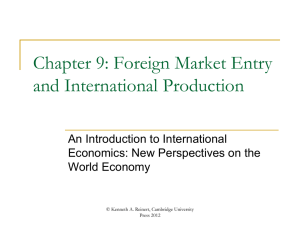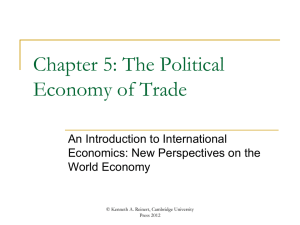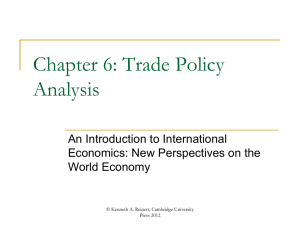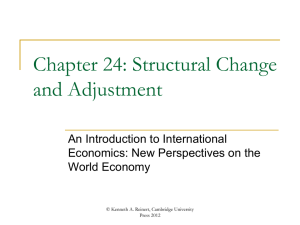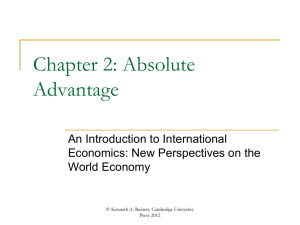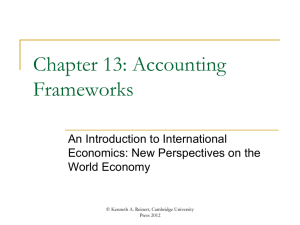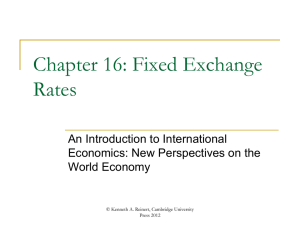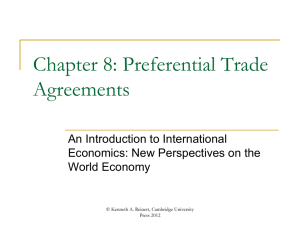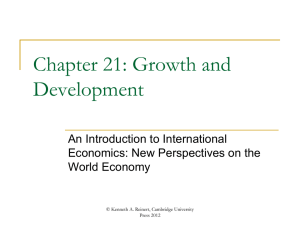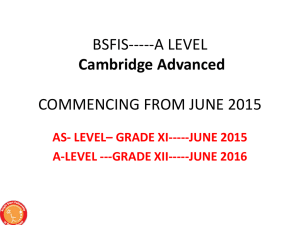Chapter 4: Intra-Industry Trade. - An Introduction to International
advertisement
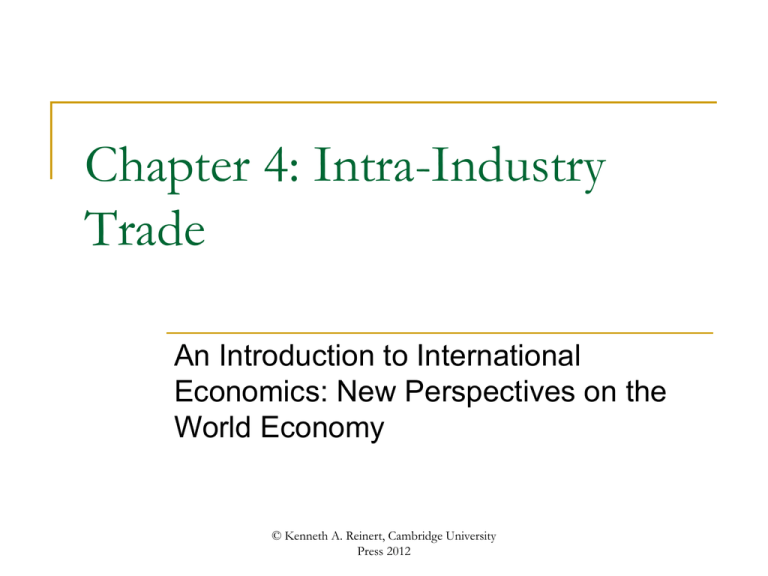
Chapter 4: Intra-Industry Trade An Introduction to International Economics: New Perspectives on the World Economy © Kenneth A. Reinert, Cambridge University Press 2012 Analytical Elements Countries Sectors Tasks Firms Factors © Kenneth A. Reinert, Cambridge University Press 2012 Table 4.1: Types of Trade Type of Trade Phrase Meaning Source Inter-industry Either/or Either imports or exports in a given sector of the economy Comparative advantage Horizontal intra- Both/and/ industry same Both imports and exports Product in a given sector of the differentiation economy at the same stage of processing. Vertical intraindustry Both imports and exports in a given sector of the economy at different stages of processing. Both/and/ different © Kenneth A. Reinert, Cambridge University Press 2012 Fragmentation (comparative advantage in some instances) Figure 4.1 The Evolution of Intra-Industry Trade at the 5and 3-Digit SITC Levels (percent of total trade) © Kenneth A. Reinert, Cambridge University Press 2012 Global Patterns of Intra-Industry Trade Approximately one third of world trade takes place as intra-industry trade Especially prominent in manufactured goods among the developed or high-income countries of the world Probably accounts for up to 70% of trade Globally, intra-industry trade is becoming more important over time, particularly in Asia © Kenneth A. Reinert, Cambridge University Press 2012 Global Patterns of Intra-Industry Trade The increasing extent of intra-industry trade in world trading system has some important implications for the adjustment of economies to increasing trade Increases in inter-industry trade based on absolute or comparative advantage involve import sectors contracting and export sectors expanding Requires that productive resources, most notably workers, shift from contracting to expanding sectors in order to avoid unemployment Not always an easy process—often gives rise to calls for protection © Kenneth A. Reinert, Cambridge University Press 2012 Global Patterns of Intra-Industry Trade The adjustment process in the case of intra-industry trade is very different A given sector experiences increases in imports and exports simultaneously Workers are less likely to need to shift between sectors Demands for protection from increased imports are less likely This is known as the “smooth adjustment hypothesis” Smoothness: Inter-industry trade: Vertical intra-industry trade: Horizontal intra-industry trade: Low (not at all smooth) Medium (somewhat smooth) High (smooth) © Kenneth A. Reinert, Cambridge University Press 2012 An Explanation of Intra-Industry Trade Will develop an explanation of intra-industry trade using the example of US trade in cheese Have to allow for product differentiation among types of cheese Will restrict ourselves to two types of cheese: blue cheese (denoted by B) and food-service cheese (denoted by F) This situation is represented in Figure 4.2 Trade implications of these supply and demand relationships are illustrated in Figure 4.3 © Kenneth A. Reinert, Cambridge University Press 2012 Figure 4.2: Markets for Blue and FoodService Cheese © Kenneth A. Reinert, Cambridge University Press 2012 Figure 4.3: U.S. Intra-Industry Trade in Cheese © Kenneth A. Reinert, Cambridge University Press 2012 Gains from Intra-Industry Trade Does intra-industry trade in cheese benefit the United States, or is it unnecessary and wasteful? Take up this issue in Figure 4.4 Areas B and D represent gains from trade © Kenneth A. Reinert, Cambridge University Press 2012 Figure 4.4: The Gains from IntraIndustry Trade © Kenneth A. Reinert, Cambridge University Press 2012 Grubel-Lloyd Index The Grubel-Lloyd index looks at a given product category denoted by letter i It is calculated as: E Z This index is illustrated in Figure 4.5 B i 1 100 E i Z i i i Pure inter-industry trade is along the axes Pure intra-industry trade is along the 45 degree diagonal © Kenneth A. Reinert, Cambridge University Press 2012 Figure 4.5: Visualizing the Grubel-Lloyd Index © Kenneth A. Reinert, Cambridge University Press 2012 The Grubel-Lloyd Index for China The Grubel-Lloyd Index for China is presented in Table 4.2 Note as we disaggregate further (moving from right to left), the amount of intra-industry trade declines but does not disappear Note that the amount of intra-industry trade increases over time © Kenneth A. Reinert, Cambridge University Press 2012 Table 4.2: Measuring China’s Intra-Industry Trade Using the Grubel-Lloyd Index. Source: Van Marrewijk (2009) Year 3-digit SITC or 237 Sectors 2-digit SITC or 237 Sectors 1-digit SITC or 10 Sectors 1980 20 30 63 1985 20 29 44 1990 36 45 60 1995 38 48 67 2000 39 48 57 2005 42 49 58 © Kenneth A. Reinert, Cambridge University Press 2012
